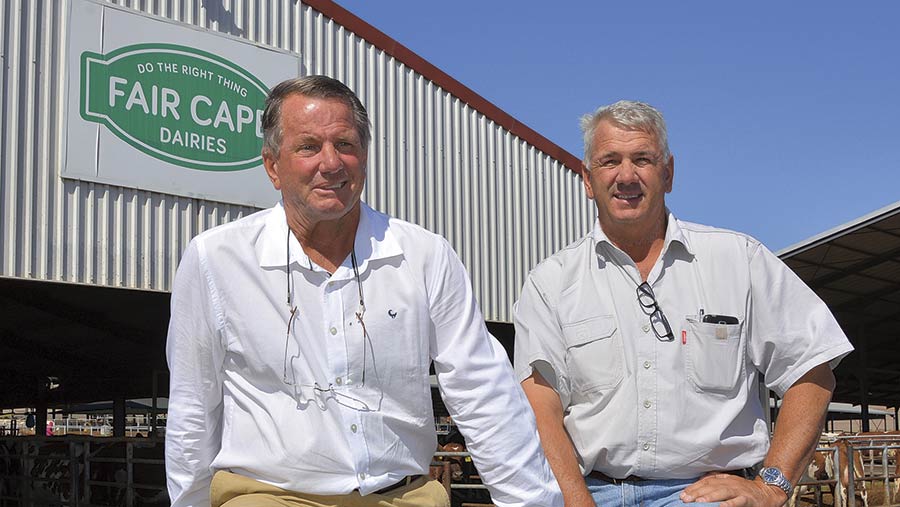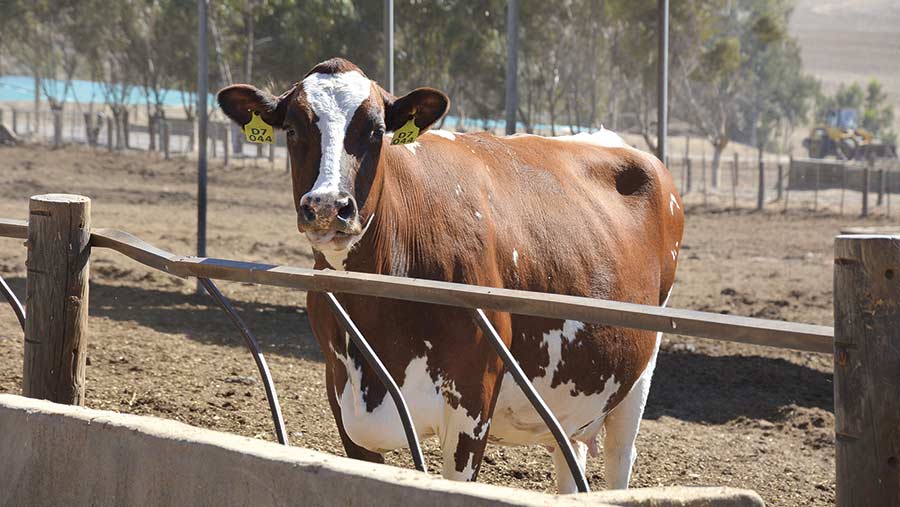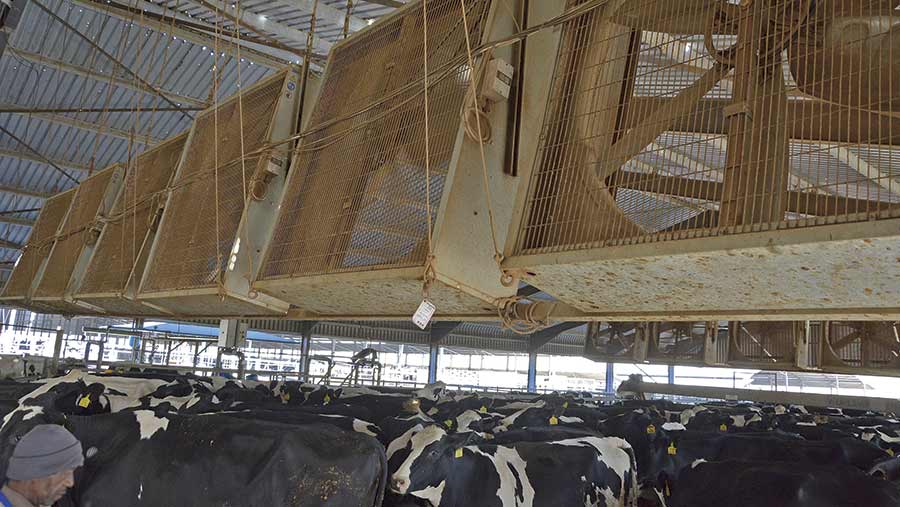How South African dairy farms are surviving rising costs
South African dairy farmers are concerned that Brexit could cause more cheap milk from the UK and Europe to be dumped on to their already struggling market.
Being in a free-market system means that South Africa has very low import tariffs with neighbouring countries, and for 15 African states there are no tariffs at all.
South African farmers receive no subsidies, and escalating costs of production caused by labour shortages and increases in feed and electricity prices have pushed up production costs to R5 (30p/litre) on some units.
This means these dairy farmers are only just breaking even, with farmgate prices floating at R4.80-5.00 (29-30p/litre).
See also: Dairying in drought: Farmer views from Australia and South Africa
In order to survive many dairies are turning to processing their own milk.

Melt Loubser (left) with his brother Johannes at their Fair Cape Dairies Farm
Fair Cape Dairies is adding value to their milk by producing and processing 88,000 litres of milk a day for their own range of produce.
At Fair Cape it costs R5.00 (29p) to produce one litre of milk but they receive R5.40 (32p) per litre for milk by processing it into their own bottled milk, yoghurt, desserts and flavoured milk.
The herd of 2,500 cows are milked three times daily and animals average up to 40 litres a day.
The business, which is located 35km from Cape Town, is run by five brothers of the Loubser family.
Melt Loubser is the chief executive and his brother Johannes looks after the dairy herd.
Milk quality
Although the herd comprises mainly Holstein cows, 350 Ayrshires and 250 Jerseys were introduced to increase the overall milk quality.

Youngstock and dry cows are kept outdoors in corrals
“The Ayrshire cows were introduced to the herd eight years ago. The Jerseys were introduced as a bit of a hobby herd but they also make a valuable contribution to our milk quality and supply.
“As we send milk to produce different dairy products, we require higher levels of protein and butterfat, and the Ayrshire breed can help achieve that in the mix,” explains Johannes.
The Holsteins are producing milk at 3.7% butterfat, while the Jerseys and Ayrshires are hitting 4.3% butterfat.
Housing and heat
Cows are kept indoors all year in temperature-controlled sheds to reduce the heat stress.
Shed temperatures are kept approximately 10 degrees cooler than outside using large fans. Fine mists of water are also sprayed on the animals in a bid to create “a winter climate” in the sheds during the hot summer season.

Huge fans keep the herd cool
The milkers are housed in free-stall cubicles with deep Israeli bedding, a form of green bedding that Johannes started using following a trip to Israel where he first saw it.
“The bedding is separated from slurry using an on-farm separator to produce 65% dry matter and 35% moist,” explains Johannes, who adds that the leftover liquid manure is spread onto fields 12 months of the year.
The other young dairy animals and dry cows are kept in outdoor feeding corals, but the staff keep a close eye on them to watch out for heat stress, with shaded areas available in the open corrals.
Weighing
Cows are weighed three times a day, upon exiting the parlour, in order to detect any major weight fluctuations, which could possibly indicate disease or some other problem.
Each cow has individual digital tags and weight fluctuations are flagged up by a text message that is sent to the farmer.
This is used to help ensure AI is targeted at the right animal, alongside automatic heat detection.
“We use AI throughout the entire herd and cannot afford to miss any cows in heat. If any cows are detected with a significant weight differential they are separated and culled rather than being treated by the vet, which is costly,” he adds.
Calf mortality is low at 6%, compared with a national average of 11%, so cow culling rates have had to be increased to control escalating numbers, with culling rates sitting at about 3.5% a month.
While the heifer calves are all raised on the farm, the bull calves are sold for R500 (£30/head) to feedlot buyers, who fatten and slaughter them.
“The Holsteins are lasting 2.5 to three lactations, which is almost double the national average of 1.6. And the figure for the Jerseys is 3.46 lactations,” says Johannes.
Cows are also culled earlier in lactation if they do not meet the minimum levels of production and or type.
Fair Cape Dairies farm facts:
- Milking 2,500 cows with 5,000 animals in total
- Produces around 70m litres of milk a year
- Cows are milked three times a day through a 64-point Rockwood rotary parlour
- Holsteins average 40 litres a day; Ayrshires averaging 30 litres a day and the Jerseys 22 litres a day
- Started in 1995, they now produce 1.5 million litres of fresh milk, 1.5 million litres of long-life milk, 1.2 million litres of yoghurt, 400,000 litres of dessert and milkshakes and a further 1.2 million litres of fruit juice each month
- 50 employees
- The farm has 2,500ha of workable land and harvests 1,000ha of wheat each year, with an average yield of 4.5 tonnes per hectare over the past five years. Another 1,500ha of maize silage, lupins and oats is grown.
